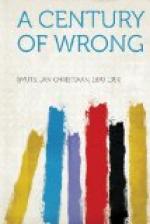Sir Bartle Frere acknowledged in a letter to Sir Robert Herbert dated 12th January, 1879, that he could not understand how it was that the Zulus had left Natal unmolested for so long, until he found out that the Zulus had been thoroughly subdued by the Boers during Dingaan’s time. Just before the Annexation a small patrol of Boers had pursued the Chief Umbeline into the very heart of Zululand. But Bishop Colenso points out clearly what a fraudulent stalking horse the Zulu difficulty was. There had been a dispute of some years standing between the Transvaal and the Zulus about a strip of territory along the border, which had been claimed and occupied by the Boers since 1869. The question was referred to Shepstone before the Annexation, while he was still in Natal, and he gave a direct decision against the Boers, and in favour of the Zulus. There was thus no cause on that account for the fear of a Zulu attack upon the Transvaal. But scarcely had Shepstone become administrator of the Transvaal when he declared the ground in dispute to be British territory, and discovered that there was the strongest evidence for the contention of the Boers that the Zulus had no right to the ground. Bulwer, the Governor of Natal, appointed a Boundary Commission, which decided in favour of the Zulus, but Shepstone vehemently opposed their verdict, and Bartle Frere and the High Commissioner (Wolseley) followed him blindly.[26] The result was that England sent an ultimatum to the Zulus, and the Zulu War took place, which lowered the prestige of England among the Natives of South Africa.
It will thus be seen that Shepstone’s two chief reasons for the Annexation were devoid of foundation.
It was naturally difficult for the Secretary of State to justify his instructions that the Annexation of the Transvaal was only to take place in case a majority of the inhabitants favoured such a course, in face of the fact that 6,800 out of 8,000 burghers had protested against it.
But both Shepstone and Lord Carnarvon declared without a shadow of proof that the signatures of the protesting petitions were obtained under threats of violence. The case, indeed, was exactly the reverse. When the meeting was held at Pretoria to sign this petition, Shepstone caused the cannons to be pointed at the assemblage. As if this were not enough, he issued a menacing proclamation against the signing of the petition.
When these pretexts were thus disposed of, they relied on the fact that the Annexation was a fait accompli.
Delegates were sent to England to protest against the Annexation, but Lord Carnarvon told them that he would only be misleading them if he held out any hope of restitution. Gladstone afterwards endorsed this by saying that he could not advise the Queen to withdraw her Sovereignty from the Transvaal.
When it was represented that the Annexation was a deliberate breach of the Sand River Convention, Sir Bartle Frere replied, in 1879, that if they wished to go back to the Sand River Convention, they might just as well go back to the Creation!




